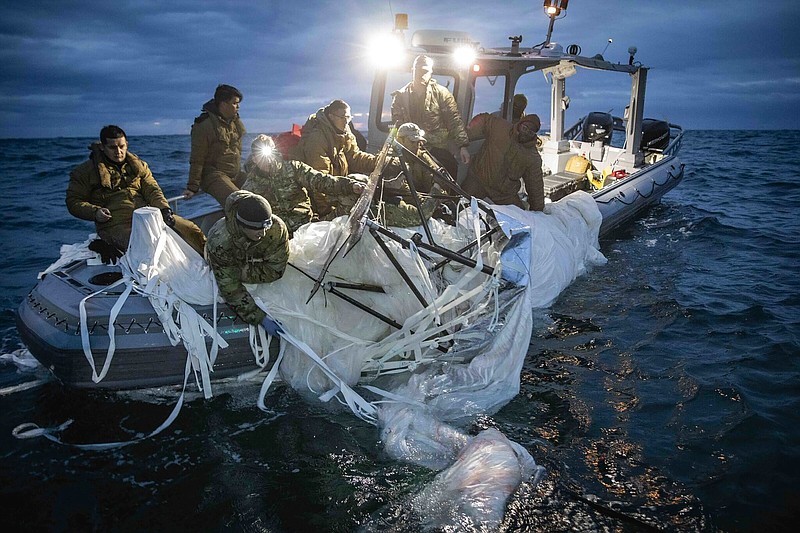WASHINGTON -- Using underwater drones, warships and inflatable vessels, the Navy is carrying out an extensive operation to gather all of the pieces of the large Chinese spy balloon a U.S. fighter jet shot down Saturday off the coast of South Carolina.
In the newest images released Tuesday by the Navy, sailors from Explosive Ordnance Disposal Group 2 are seen leaning over a rigid-hull inflatable boat and pulling in broad swaths of the balloon's white outer fabric and shell structure.
The head of U.S. Northern Command, Gen. Glen VanHerck, said Monday the teams were taking precautions to safeguard against the chance any part of the balloon was rigged with explosives.
The balloon was an estimated 200 feet tall and was carrying a long sensor package underneath, which VanHerck estimated was the size of a small regional jet.
The Navy is also using ships to map and scan the sea floor for all remaining parts of the balloon, so U.S. analysts can get a full picture of what types of sensors the Chinese were using and to better understand how the balloon was able to maneuver.
The balloon debris is scattered in waters that are about 50 feet deep, but stretch across an area 15 football fields long and 15 football fields across, VanHerck said.
FURTHER DETERIORATION
China said Tuesday it will "resolutely safeguard its legitimate rights and interests" over the U.S. shooting down of the suspected spy balloon, as relations between the two countries deteriorate further.
The balloon prompted U.S. Secretary of State Antony Blinken to cancel a highly anticipated visit to Beijing this week that had offered slight hopes for an improvement in relations.
China claims it was a civilian balloon used for meteorological research but has refused to say to which government department or company it belongs. Foreign Ministry spokesperson Mao Ning reiterated Tuesday that the "unmanned airship" posed no threat and entered U.S. airspace accidentally.
Mao again criticized the U.S. for overreacting rather than adopting a "calm, professional" manner, and for using force in bringing the balloon down.
"The balloon does not belong to the U.S. The Chinese government will continue to resolutely safeguard its legitimate rights and interests," Mao said at a daily briefing without giving further details.
Beijing's attitude has hardened considerably following a surprisingly mild initial response on Friday, in which it described the balloon's presence as an accident and expressed "regret" for the balloon having entered the U.S.
Subsequent statements have grown firmer, in the same tone used to confront the U.S. over issues from Taiwan to trade, technology restrictions and China's claim to the South China Sea. China says it lodged a formal complaint with the U.S. Embassy in Beijing, accusing Washington of having "obviously overreacted and seriously violated the spirit of international law and international practice."
Balloons either suspected of or confirmed to be Chinese have been spotted over countries from Japan to Costa Rica. Taiwanese media have reported that mysterious white balloons had been spotted over the island at least three times in the past two years.
That's especially concerning because China claims Taiwan as its own territory to be brought under its control by force if necessary and routinely sends warships and military aircraft into the island's air defense identification zone and across the middle line of the Taiwan Strait dividing the sides.
Taiwan's Ministry of National Defense has never explicitly linked the balloons to China. However, the size of the Chinese balloon in the U.S., as well as the equipment attached to it, had all drawn intense speculation as to its purpose.
Along with Washington, most security experts dismissed Beijing's assertions that the balloon was intended for meteorological rather than spying purposes. It doesn't look like any weather balloon that Cheng Ming-dian, head of Taiwan's Central Weather Bureau, has seen.
"In the meteorology world, I haven't found a person who has seen or heard of a weather balloon that looks like this," Cheng said.
While China has in recent months moderated the abrasive tone of its diplomacy, "if you cast the change in rhetoric aside, we're in fact not seeing any real meaningful improvement in the extant China-U.S. relations, which will continue to be dominated by rivalry," said Collin Koh Swee Lean, a research fellow at the Institute of Defense and Strategic Studies at Singapore's Nanyang Technological University. "And the latest spy balloon incident only looks set to broaden the schism."
Information for this article was contributed by Tara Copp and Huizhong Wu of The Associated Press.
